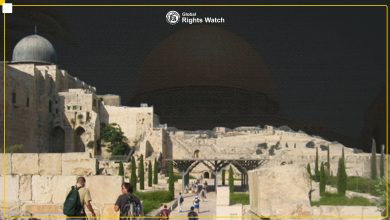Torture and abuse in Sydnaya prison
Sidnaya Prison is a military prison of the Syrian Ministry of Defense, run by the military police, located near the town of Sidnaya, north Damascus, about 30 km from the heart of the capital.
The prison in Damascus Rural Province is notorious for being one of the most egregious Syrian prisons, where prisoners are subjected to the harshest forms of torture, including sexual abuse, and harm through sensitive physical locations, according to the association of prisoners and missing persons in Sidnaya Prison, which talked about the detention procedures in this prison, considered as major centre for the detention and forced concealment of political detainees subjecting them to fatal living conditions.
The report was based on interviews with former detainees in this prison, which revealed how the security establishment interrogated the detainees using physical and psychological torture. The report confirms that, after 2011, the Syrian regime has resorted to the Military Court for the prosecution of civilian detainees. The Military Court lacks the minimum conditions for a fair trial.
The Association also reported on the existence of resolutions of the ruling regime stipulating the “seizure of the property of detainees after the seizure of their liberty”. The report revealed the corruption of senior State officials, as well as the existence of a large network of officials, powerful persons and some judges and lawyers who carry out financial extortion of the families of detainees and forcibly disappeared, in exchange for visits to places of detention or promises of eviction.
During the war, dozens of prisoners were taken at night from their cells to the basement where they were subjected to the most heinous torture before being executed. The victims’ bodies are then trucked and buried in mass graves on military land outside Damascus. Former prisoners have spoken of an endless spiral of torture: They also reported being beaten with plastic hoses, silicone bars, wooden sticks and burning with cigarette butts. Others were forced to stand in the water and receive electric shocks.
In 2017, Amnesty International published a report entitled Human Slaughterhouse, in which it reported on the conditions of detention, torture and death in Sidnaya prison, based on testimony from former prisoners, officers and dissident guards, and estimated that between 5,000 and 13,000 people were executed by the regime by hanging in Sidnaya prison between 2011 and 2016.
Human rights organizations should work purely humanitarian
One journalist, Milad Shahabi (who has two brothers in Syrian prisons), asked that the testimony of prisoners who leave the prisons alive be a factor of pressure from the international community on the State, forcing the latter to allow international organizations to enter Sidnaya prison and examine the facts on the ground. He also called for the occasional exchanges of prisoners between the regime and armed groups to include political detainees in Sidnaya prison, not just Adra prison.
The international community has so far failed to open this issue despite its importance and tragic repercussions, especially since all the regime’s detention facilities are like human slaughterhouses. According to a human rights defender (Haytham Menna), the Office of the United Nations High Commissioner for Human Rights (OHCHR) did not act when it was asked more than once to intervene for the 36 serious cases brought to Sidnaya prison before the Syrian war. Cases were sentenced in field courts and never subject to a court ruling, some twenty years ago, on charges of belonging to the Muslim Brotherhood movement.
International and Arab human rights organizations focus on Adra prison detainees, considering the injustice inflicted on them as a result of their struggle to revive a civil society demanding the overthrow of the regime and the peaceful transition to democracy.
Conclusion
It can be said that the conditions of Syrian prisons are no different from those in Egypt, Iraq, Palestine, Saudi Arabia, Tunisia, Yemen and other Arab countries.
However, the worst reputation is not for Al-Hayer prison in Saudi Arabia, nor the Egyptian or Iraqi prisons, but rather the Syrian prisons, because the lack of honesty and transparency in the Syrian security services made people accept any news. So did some human rights organizations that work with political agendas, which led to a conflict in the number of detainees in prisons. The weakness of the human right organizations working without political agenda contributed as well to this confusion about numbers.
The use of politics in a sensitive rights issue requires every effort to uncover its facts, although reporting about human rights violations is not a point of view. It is first and foremost a moral trust and a legal responsibility.
In a statement, the National Coalition said that there was no value in international legitimacy if the international community did not deal with this file with a human and legal sense. The coalition urged the international community to do what is necessary to ensure that international human rights organizations have access to the regime’s prisons in order to control the conditions of civilians ‘detention. Several humanitarian organizations and human rights networks also issued statements and reports on the occasion of the “ International Day in Support of Victims of Torture”, calling the international community for a firm attitude towards the torture of detainees in Syrian prisons.
Rights organizations must fight tirelessly for the release of all prisoners of opinion, improve the conditions of poor prisons in Syria, and demand that the tragedy of Sidnaya prison be investigated and that the conditions of this and other prisons on Syrian territory be reformed.






